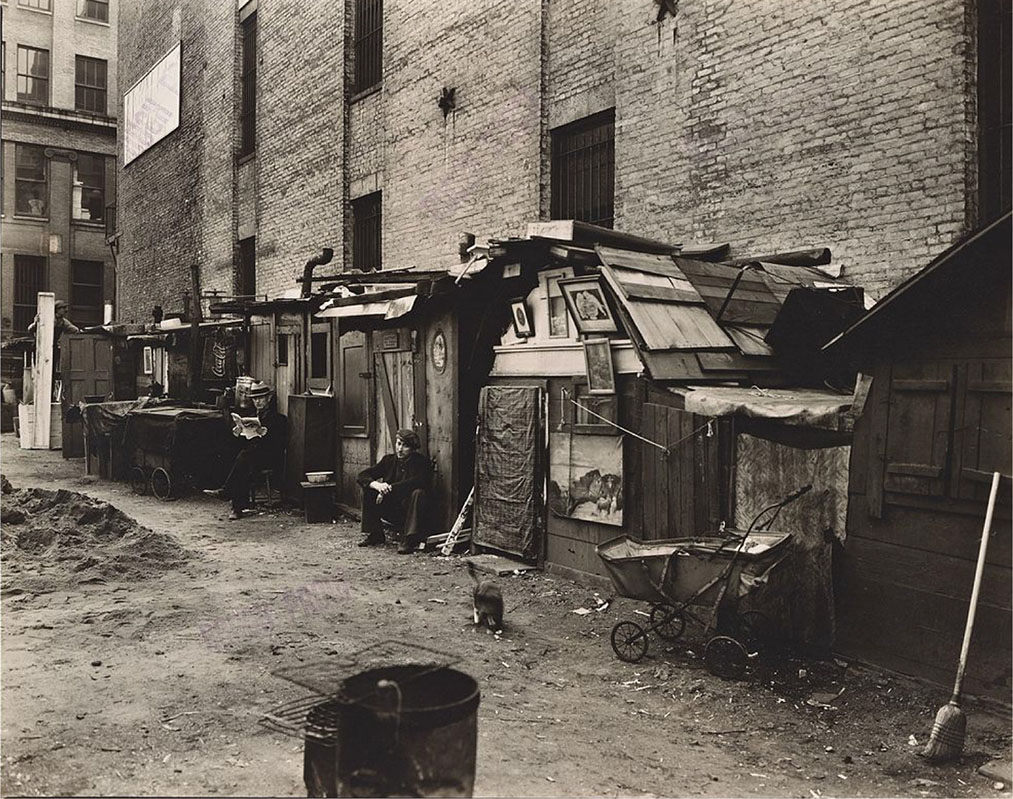Module 9: Brother, Can You Spare a Dime? The Great Depression, 1929-1932
Section outline
-
 Image from Chapter 25 of U.S. History (opens in new window) from OpenStax, licensed under Creative Commons Attribution License v4.0 with the image information: In 1935, Berenice Abbott photographed these shanties in Lower Manhattan during the Great Depression. (credit: modification of work by Works Progress Administration)This module will explore the Great Depression. The prosperous decade of the 1920s led to the stock market crash of 1929. President Hoover’s deeply held philosophy of American individualism made him particularly unsuited to deal with the crisis of the Great Depression. The American public ultimately responded with anger and protest to Hoover’s apparent inability to create solutions. The Great Depression affected huge segments of the American population—sixty million people by one estimate. But certain groups, such as African Americans and Latinos, were hit harder than the rest. Hoover's record as a president will likely always bear the taint of his unwillingness to push through substantial government aid but, while his attitude toward civil rights mirrored his conviction that government intervention was a negative force, he did play a key role changing living conditions for Native Americans.Upon completion of this module, you will be able to:
Image from Chapter 25 of U.S. History (opens in new window) from OpenStax, licensed under Creative Commons Attribution License v4.0 with the image information: In 1935, Berenice Abbott photographed these shanties in Lower Manhattan during the Great Depression. (credit: modification of work by Works Progress Administration)This module will explore the Great Depression. The prosperous decade of the 1920s led to the stock market crash of 1929. President Hoover’s deeply held philosophy of American individualism made him particularly unsuited to deal with the crisis of the Great Depression. The American public ultimately responded with anger and protest to Hoover’s apparent inability to create solutions. The Great Depression affected huge segments of the American population—sixty million people by one estimate. But certain groups, such as African Americans and Latinos, were hit harder than the rest. Hoover's record as a president will likely always bear the taint of his unwillingness to push through substantial government aid but, while his attitude toward civil rights mirrored his conviction that government intervention was a negative force, he did play a key role changing living conditions for Native Americans.Upon completion of this module, you will be able to:- Identify the causes of the stock market crash of 1929 (CO 1-5)
- Assess the underlying weaknesses in the economy that resulted in America’s spiraling from prosperity to depression so quickly (CO 1-5)
- Compare how the stock market crash impacted different groups in America (CO 1-5)
- Explain Herbert Hoover’s responses to the Great Depression and how they reflected his political philosophy (CO 1-5)
- Describe the causes, objectives, and outcomes of Great Depression protests (CO 1-5)
- Analyze the frustration and anger that a majority of Americans directed at Herbert Hoover (CO 1-5)
- Identify the challenges that everyday Americans faced as a result of the Great Depression and analyze the government’s initial unwillingness to provide assistance (CO 1-7)
- Explain the particular challenges that African Americans faced during the crisis (CO 1-5)
- Identify the unique challenges that farmers in the Great Plains faced during this period (CO 1-7)
- Explain the Great Depression's influence on American values and popular culture (CO 1-7)
- Identify the successes and failures of Herbert Hoover’s presidency (CO 1-7)
- Determine the fairness and accuracy of assessments of Hoover’s presidency (CO 1-7)
To achieve these objectives:
- Read the Module 9 Introduction above.
- Read and view the materials in Module 9 (click below)
- View the Module 9 PowerPoint below.
- Complete Module 9 quizzes/assignments/discussion boards based on chapter/document reading.
Module Pressbooks Resources and Activities
You will find the following resources and activities in this module at the Pressbooks website. Click on the links below to access or complete each item.
Background Colour
Font Face
Font Kerning
Font Size
Image Visibility
Letter Spacing
Line Height
Link Highlight
Text Colour
